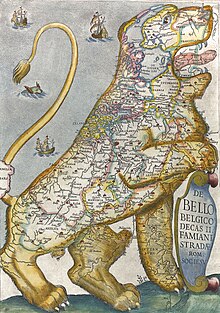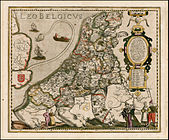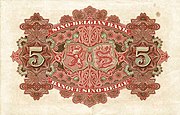Leo Belgicus

The Leo Belgicus (Latin for Belgic Lion) was used in both heraldry and map design to symbolize the former Low Countries (current day Netherlands, Luxembourg, Belgium and a small part of northern France) with the shape of a lion.
When not in map form, the Leo Belgicus often accompanies the
Europa regina, showing Europe as a queen, was a comparable schematic.
Terminology
The names derived from the
History
The earliest Leo Belgicus was drawn by the
.Eytzinger's map was the first of many. There were three different designs. In the most common one, the lion's head was located in the northeast of the country and the tail in the southeast. The most famous version is that of
The third version was published in the later stages of the war, and after the independence of the Dutch Republic was confirmed in the Peace of Westphalia (1648). It is called the Leo Hollandicus, the Holland Lion, and shows only the province of Holland. One of the earliest versions was published by Visscher around 1625.
Gallery
-
Leo Belgicus by Claes Janszoon Visscher, 1611
-
Leo Belgicus by Jodocus Hondius, 1611
-
Leo Belgicus byKaerius(vd Keere), 1617
-
Leo Belgicus by Hondius & Gerritsz, 1630
-
Leonis Hollandiae by Visscher 1648
-
Leo by Visscher, 1650
-
Leo by Schenk 1707
-
A Leo Belgicus map by Famiano Strada, 1648
-
A Dutch coin of 1753 depicting the Leo Belgicus holding aGarden of Holland
-
Patriotic scene on aCap of Liberty, and putto with a cornucopia, inscribed "The Batavian Commonwealth", c. 1765, stipple engraving by David Wolff.
-
Symbol of the Batavian Republic, 1795-1806; the Dutch Maiden and Leo Belgicus.
-
The Monument to the Martyrs of the 1830 Revolution in Brussels, Belgium surmounted by statues for Liberty and Leo Belgicus.
-
5 Mexican Dollars Local Currency issued by Sino-Belgian Bank, reverse side. 1908.
See also
References
- Matthaeus Seutter, from 1745,which show the current Netherlands. Archived 2012-08-25 at the Wayback Machine
External links
![]() Media related to Leo Belgicus at Wikimedia Commons
Media related to Leo Belgicus at Wikimedia Commons














